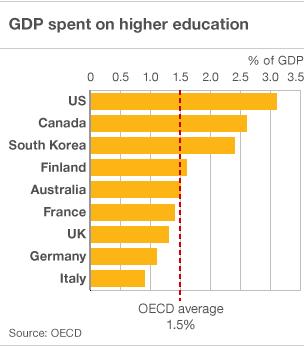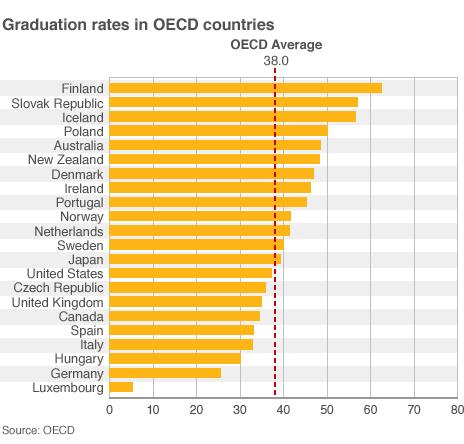How about 80% going to university?
- Published

The numbers going to university have doubled in industrialised countries since the mid-1990s
The government is set to respond to Lord Browne's review of funding - with the expectation that it will see tuition fees rising to up to £9,000 per year.
The funding review was intended to protect a "world class" higher education system. But how does the UK compare to international competitors?
In Finland, 80% of young women are now going to university. It's currently the highest proportion of graduates in the world.
All those blue-skies conversations about a "graduate economy" have already arrived in parts of the European continent. In Iceland, 78% of women are getting degrees, in the Slovak Republic it's 77%.
You can hear taxi drivers howling in irritation. All those pointless courses. More degrees than a protractor factory. Who's paying for all those courses?
Except there could already be 80% going to university in the UK. It just depends how you count it. Or more specifically where you count it.
If the cab was driving through the well-heeled streets of Kensington and Chelsea in London more than 80% of young people are already going to university.
And based on the last detailed local figures, in places in south west London such as Richmond and Wimbledon, about two in three youngsters will be getting university places.
Slipping down
But what has this got to do with the arguments over student fees?
It's because a driving force behind Lord Browne's review into university funding has been the need to keep up with global rivals.
Compared with international competitors the UK has been slipping back in the numbers of people going to university.
The UK has fallen from third to fifteenth in the international league of graduate numbers between 2000 and 2008, according to OECD figures.
According to this measure, there are now 30% of men and 40% of women in each year group in the UK leaving with degrees.
It's not that the UK has fewer graduates, the number has risen year after year - it's that the number has not increased as rapidly as other industrial nations.
The UK has been overtaken by countries such as Poland, Portugal, the Netherlands, Ireland, Sweden, the Czech Republic and Denmark.
Degrees of separation
Across the OECD, between 1995 and 2008, the proportion of young people going to university doubled - from 20% to almost 40%. It has been a huge and largely unheralded social change.

Parents of new students sleep on a gym floor at the start of the university term at Wuhan in China
It's moved from a minority activity to a mainstream expectation - a gateway to middle-income employment. There are now more people getting degrees in the UK than would have had A-levels a generation ago.
But what's particularly distinctive about the numbers going to university in the UK is the polarisation of local differences.
Youngsters in affluent areas are five times more likely to go to university than their counterparts in the poorest areas.
At the extremes, the range is even wider. The last detailed local figures, gathered almost a decade ago, showed that only 8% went from Sheffield Brightside and 9% in Nottingham North.
Even though the numbers will have risen - and girls will be more likely to get places than boys - it's a massive divide.
What does that mean for international comparisons? It would put south west London shoulder to shoulder with the Scandinavian countries and parts of Sheffield and Nottingham alongside Mexico and Turkey.
More for less
There is another unacknowledged watershed in Lord Browne's review - in that almost no one is calling for fewer students.

The challenge is to get more students through the doors, at a cost that is affordable to the student and the taxpayer.
Both partners in the coalition government and the opposition accept the broad principle that the economy is going to require more graduates - and that more families will expect their children to get university places.
But what's this going to cost? And how does spending compare now?
As a percentage of national wealth, the UK is below the OECD average for spending on higher education. The amount has risen, but not as rapidly as elsewhere.
The UK spends 1.3% of GDP on higher education - lagging behind 3.1% in the US, 2.4% in South Korea and 2.6% in Canada. Within Europe, the UK is behind countries including France, Denmark, Finland, Sweden, Portugal and the Netherlands.
Rising fees
But there's another way of measuring this.
In cash terms, in dollars spent per student, the UK has a much more positive outlook. It's above average for industrial countries and higher than countries such as France, Japan, Germany, Italy and Finland.
For example, in the UK the average amount spent per student, including fees, is $15,000 (£9,400) per year - in Italy it is less than $9,000 (£5,700).
But there are big differences in how this income can be delivered.
Higher education in the US receives the highest proportion of GDP in the world - but two thirds of this is from the private sector. Leading universities in the US now charge students $50,000 (£31,400) per year.
In Finland, there are no fees for home students, and about 94% of spending on higher education comes from the public sector.
In this spectrum, the English system of fees and taxpayer support falls somewhere in the middle ground, between the US free market and the Scandinavian state-funded approach.
A key issue - and a big concern for universities - is whether the current funding review will be about putting extra money into higher education - or whether it will replace public funding with increased fees. Will it switch the balance rather than increase the overall amount?
Students at English universities will also be looking at international comparisons in terms of the current level of tuition fees. England is already in the top five for fees - alongside the US, South Korea, Japan and Australia.
The charging of fees is spreading - with English-speaking and Asian countries at the forefront. The most striking difference is in Scandinavia, which remains resistant to such charges.
But fees have to be set against the availability of bursaries and loans, particularly for low-income families. In this respect, in terms of the proportion of the higher education budget spent on student support, England spends similar levels to Norway and Denmark.
There have been relentlessly upward international trends in the past decade - more students, more graduate jobs, more applicants for places, more money pumped into universities.
This appetite for university shows no sign of diminishing. But the next big question, from New York to Nottingham, is going to be who pays for it?

Estimated percentages of 2008 age cohort which will complete first-time academic degrees, out of 26 OECD countries, plus Australia figure for 2007.